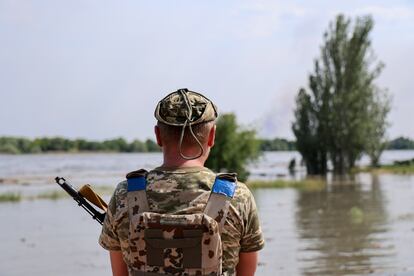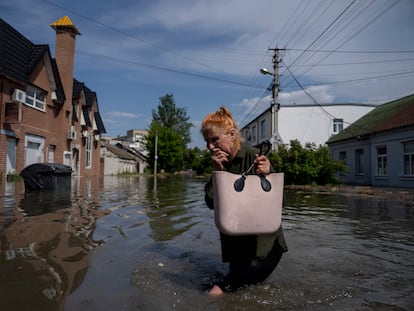Nova Kakhovka dam disaster hinders Ukrainian offensive against Russian forces on the Dnipro
The flooding caused by the breach benefits Moscow militarily by hampering attacks on a key area of the front. Military analysts say it could set Kyiv back weeks and cause a huge ecological catastrophe


Total war, as described by Emmanuel Kreike, professor of history at Princeton University, is one in which “everything is a target and everything can serve as a weapon; the human and the non-human,” an observation that fits perfectly with the destruction of the Nova Kakhovka dam. A civilian infrastructure under the control of an army, in this case Russia’s, which has caused a catastrophe that will lead not only to serious humanitarian and environmental consequences but also immediate military concerns: tripling the flow of the Dnipro River over the course of its final 60 kilometers (37 miles) to the Black Sea, in addition to leaving dozens of villages uninhabitable and displacing thousands of people, will hinder the Ukrainian counteroffensive.
Direct responsibility for the collapse of the dam has yet to be clarified but militarily, Moscow is the biggest beneficiary. Lieutenant general Serhii Nayev, Commander of the Joint Forces of the Armed Forces of Ukraine, told a press briefing on Tuesday that the General Staff had foreseen the possibility of Russian forces blowing the dam and as such plans for the counteroffensive are still underway. But Nayev also admitted that the priority now is civilian assistance in the area. It is expected that the water level could rise by up to five meters on Wednesday before beginning to recede on Thursday, Ukrinform, the state news agency, reported.
“In the current situation of civilian aid, it will not be possible to carry out military operations in the area, possibly for weeks,” Jérôme Pellistrandi, a retired French army general and military analyst, told EL PAÍS. Pellistrandi is less optimistic than Nayev and describes the destruction of the dam as a “serious setback for Ukrainian military interests.”
As it flows through the Dnipropetrovsk and Kherson provinces, the Dnipro forms a natural line of separation between the two armies. Since early spring, Ukrainian special forces and naval troops had been carrying out landings on the eastern bank in Kherson, territory held by Russian forces. Ukrainian positions had been established in some areas near the delta and on islands in the river. All of these outposts had to be abandoned on Tuesday due to flooding.
Three different special forces units explained to EL PAÍS in May that they had been operating in the Russian-occupied zone for months to force the enemy to maintain troops in the region and to identify defensive positions to be destroyed when an amphibious assault was launched as part of the counteroffensive. “A diversionary attack towards Crimea could still be attempted, but this will now be very difficult; it will require weeks to rethink this option,” says Pellistrandi.
The French general underlines that if before the dam was breached it was necessary for Kyiv’s military strategists to devise an assault on parts of the river that are 500 meters to a kilometer wide, now the distance will be between two to three kilometers (1.2-1.8 miles). “For the Russians, it is a huge tactical advantage. It would be very easy for their artillery to hit armored vehicles on pontoon bridges.” Pellistrandi notes another benefit for the Russian army: it can now redeploy troops stationed in the south to the eastern front, where the Ukrainian Army has been launching a series of attacks.
Ukrainian troops are advancing in Bakhmut and on the Zaporizhzhia front. A Ukrainian infantry officer consulted by this newspaper, as well as other military personnel interviewed by Ukrainian media, stated that Kyiv has recovered the territory that was taken in fighting throughout the spring in just three days. “A month ago, I was telling my family that all was lost, that they were going to crush us; now we are the ones who are going to crush them,” an infantry battalion commander tells EL PAÍS on the telephone. In Zaporizhzhia, Ukraine’s advances have also been confirmed by the enemy. This axis is the most strategic section of the front and key to the success of the counteroffensive because a breakthrough would allow the Ukrainian Armed Forces to advance towards the occupied territories east of the Dnipro without having to attempt a river assault.
The destruction of the Nova Kakhovka dam will make any landing on the Dnipro an even more daunting prospect. Charles Rei, a retired U.S. military officer and prominent commentator on the Russian invasion on social media, now considers a Ukrainian amphibious assault impossible: “Crossing the river through the dam and downstream was already extremely difficult; now it is technically impossible.” The dam road, moreover, no longer exists.
Mark Hertling, a retired U.S. lieutenant general, concurs with Rei that the situation will hamper both armies but the Ukrainian forces to a greater extent because although Russian defensive lines at the river’s edge have been flooded, the options for establishing a supply chain for an attempted assault across the river are extremely limited.

“The first ecocide in a modern war”
Pellistrandi also highlights the ecological catastrophe the breach of the dam will cause. Tons of polluting materials in the dam reservoir will reach the Dnipro plains and ecosystems will be affected. The ramifications for the agricultural sector will also be significant, according to the Ukrainian government. François Heisbourg, a leading analyst at the International Institute for Strategic Studies, stated on French news channel LCI that the world was witnessing “an act that can be considered as the first ecocide in a modern war.”
Kreike, one of the leading experts in the study of the use of nature as a weapon of war, notes in his book Scorched Earth that ecocide — the destruction of an ecosystem to the detriment of life — is not recognized as an international crime. The Princeton professor’s work analyzes cases of the deliberate destruction of ecosystems for military purposes and the destruction of social collectives and their territory. Kreike defines this as “environcide.” The historical examples he provides in Scorched Earth coincide with what Russia could stand accused of if it is confirmed that Moscow ordered the destruction of the Nova Kakhovka dam. The first case Kreike outlines dates from the 16th-century rebellion in the Netherlands against Philip II of Spain. The local nobility that rose up against the emperor destroyed dams that flooded vast territories and cities, causing mass migrations but allowing their warships free rein.
There are currently three hypotheses about what may have happened at Nova Kakhovka. Kyiv claims that Moscow deliberately blew the dam with explosives. While the White House has said that it cannot yet draw any firm conclusions, U.S. government sources told NBC that they had information that Russia was responsible for the catastrophe. NATO Secretary General Jens Stoltenberg and senior European Union representatives have also publicly expressed their belief that Russian troops were behind the breach.
The Kremlin, meanwhile, maintains that Ukrainian saboteurs blew up the dam. One consequence of the disaster is that the Crimean Peninsula, which was illegally annexed by Moscow in 2014, will no longer receive water through the tributary stemming from the Dnipro. The third version, which is being pushed by Russian authorities in occupied Nova Kakhovka, is that the dam collapsed because it was in poor condition. Russia has controlled the dam since the early days of the war, and Moscow and Kyiv have accused each other of shelling it. Ukraine said the troops occupying it detonated explosives last fall that damaged three sluice gates, which help regulate water levels. Signs of damage to the gates were evident in late May. On Tuesday, testimonies from both sides collated in the media and on Telegram channels showed units of both armies stationed on the river being caught by the rising water and fleeing at the last minute.
Sign up for our weekly newsletter to get more English-language news coverage from EL PAÍS USA Edition
Tu suscripción se está usando en otro dispositivo
¿Quieres añadir otro usuario a tu suscripción?
Si continúas leyendo en este dispositivo, no se podrá leer en el otro.
FlechaTu suscripción se está usando en otro dispositivo y solo puedes acceder a EL PAÍS desde un dispositivo a la vez.
Si quieres compartir tu cuenta, cambia tu suscripción a la modalidad Premium, así podrás añadir otro usuario. Cada uno accederá con su propia cuenta de email, lo que os permitirá personalizar vuestra experiencia en EL PAÍS.
¿Tienes una suscripción de empresa? Accede aquí para contratar más cuentas.
En el caso de no saber quién está usando tu cuenta, te recomendamos cambiar tu contraseña aquí.
Si decides continuar compartiendo tu cuenta, este mensaje se mostrará en tu dispositivo y en el de la otra persona que está usando tu cuenta de forma indefinida, afectando a tu experiencia de lectura. Puedes consultar aquí los términos y condiciones de la suscripción digital.
More information
Archived In
Últimas noticias
Most viewed
- Sinaloa Cartel war is taking its toll on Los Chapitos
- Oona Chaplin: ‘I told James Cameron that I was living in a treehouse and starting a permaculture project with a friend’
- Reinhard Genzel, Nobel laureate in physics: ‘One-minute videos will never give you the truth’
- Why the price of coffee has skyrocketed: from Brazilian plantations to specialty coffee houses
- Silver prices are going crazy: This is what’s fueling the rally










































